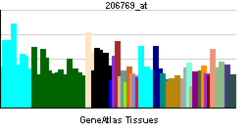Thymosin beta-4, Y-chromosomal
| Thymosin beta 4, Y-linked | |||||||||||||
|---|---|---|---|---|---|---|---|---|---|---|---|---|---|
| Identifiers | |||||||||||||
| Symbols | TMSB4Y ; TB4Y | ||||||||||||
| External IDs | OMIM: 400017 GeneCards: TMSB4Y Gene | ||||||||||||
| |||||||||||||
| RNA expression pattern | |||||||||||||
 | |||||||||||||
| More reference expression data | |||||||||||||
| Orthologs | |||||||||||||
| Species | Human | Mouse | |||||||||||
| Entrez | 9087 | n/a | |||||||||||
| Ensembl | ENSG00000154620 | n/a | |||||||||||
| UniProt | O14604 | n/a | |||||||||||
| RefSeq (mRNA) | NM_004202 | n/a | |||||||||||
| RefSeq (protein) | NP_004193 | n/a | |||||||||||
| Location (UCSC) |
Chr Y: 13.7 – 13.71 Mb | n/a | |||||||||||
| PubMed search | n/a | ||||||||||||
Thymosin beta-4, Y-chromosomal is a protein that in humans is encoded by the TMSB4Y gene.[1][2]
The protein consists (in humans) of 44 amino acids (msdkpgmaei ekfdksklkk tetqeknpls sketieqerq ages) MolWt 4881.[3]
Function
This gene lies within the male specific region of chromosome Y. Its homolog on chromosome X (thymosin beta-4) escapes X inactivation and encodes an actin sequestering protein.[2]
References
- ↑ Lahn BT, Page DC (Nov 1997). "Functional coherence of the human Y chromosome". Science 278 (5338): 675–80. doi:10.1126/science.278.5338.675. PMID 9381176.
- 1 2 "Entrez Gene: TMSB4Y thymosin, beta 4, Y-linked".
- ↑ http://www.ncbi.nlm.nih.gov/protein/NP_004193
Further reading
- Yu FX, Lin SC, Morrison-Bogorad M, et al. (1993). "Thymosin beta 10 and thymosin beta 4 are both actin monomer sequestering proteins". J. Biol. Chem. 268 (1): 502–9. PMID 8416954.
- Li X, Zimmerman A, Copeland NG, et al. (1997). "The mouse thymosin beta 4 gene: structure, promoter identification, and chromosome localization". Genomics 32 (3): 388–94. doi:10.1006/geno.1996.0133. PMID 8838802.
- <Please add first missing authors to populate metadata.> (1999). "Toward a complete human genome sequence". Genome Res. 8 (11): 1097–108. doi:10.1101/gr.8.11.1097. PMID 9847074.
- Strausberg RL, Feingold EA, Grouse LH, et al. (2003). "Generation and initial analysis of more than 15,000 full-length human and mouse cDNA sequences". Proc. Natl. Acad. Sci. U.S.A. 99 (26): 16899–903. doi:10.1073/pnas.242603899. PMC 139241. PMID 12477932.
- Skaletsky H, Kuroda-Kawaguchi T, Minx PJ, et al. (2003). "The male-specific region of the human Y chromosome is a mosaic of discrete sequence classes". Nature 423 (6942): 825–37. doi:10.1038/nature01722. PMID 12815422.
- Gerhard DS, Wagner L, Feingold EA, et al. (2004). "The Status, Quality, and Expansion of the NIH Full-Length cDNA Project: The Mammalian Gene Collection (MGC)". Genome Res. 14 (10B): 2121–7. doi:10.1101/gr.2596504. PMC 528928. PMID 15489334.
- Torikai H, Akatsuka Y, Miyazaki M, et al. (2005). "A novel HLA-A*3303-restricted minor histocompatibility antigen encoded by an unconventional open reading frame of human TMSB4Y gene". J. Immunol. 173 (11): 7046–54. doi:10.4049/jimmunol.173.11.7046. PMID 15557202.
- Rual JF, Venkatesan K, Hao T, et al. (2005). "Towards a proteome-scale map of the human protein-protein interaction network". Nature 437 (7062): 1173–8. doi:10.1038/nature04209. PMID 16189514.
This article is issued from Wikipedia - version of the Monday, July 27, 2015. The text is available under the Creative Commons Attribution/Share Alike but additional terms may apply for the media files.